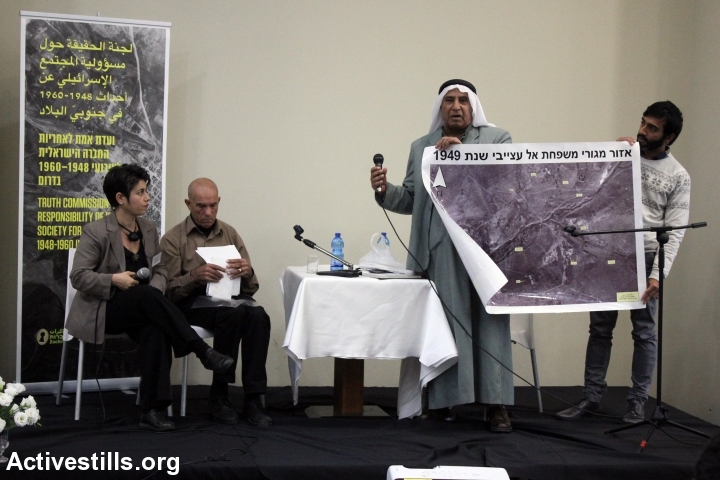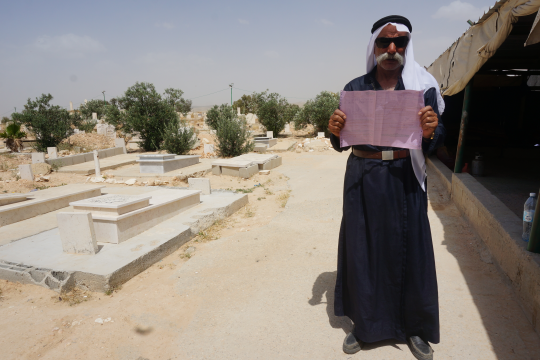An informal ‘Public Truth Commission’ set out to find exactly what happened to the Negev Bedouin between 1948 and 1960. While Bedouin witnesses told stories of massacres, rape and expulsions, former Israeli soldiers said they were just following orders.
By Tom Pessah

I identify as straight, so I cannot claim to know how it feels to be in the closet. But I do have friends who identify as LGBTQ, and they have taught me a little about what it is like: to constantly evade the subject is exhausting. If you demand that people hide such central parts of their identities, you’ll never have close relationships with them. Likewise many people I know see themselves as “pro-peace” or “pro-Palestine,” but expect Palestinians to remain “in the closet” about their history, particularly that of 1948.
Zochrot, an Israeli NGO, is experimenting with ways to bring awareness about the Palestinian Nakba to the Jewish Israeli public. After two years of preparations, they convened an informal Public Truth Commission at Ben-Gurion University in Beersheba last week, in order to examine the displacement of Palestinians in the Negev/Naqab by Israeli forces that took place from 1948 to 1960. Why until 1960? Most people are actually unaware of the fact the majority of local Bedouin tribes were driven off their lands into either Sinai, the West Bank, or an isolated reservation east of Beersheba (the “Sayag”) in the 1950s – long after the war ended.
But how can “nomads” be driven off “their lands?” Most people also do not know about the Bedouins’ semi-nomadic form of settlement, which included tilling plots of land in particular areas associated with each tribe. The Ottomans had noticed this practice in the 16th century, but Israeli state representatives have continued to deny this in court in order to justify the present-day eviction of entire communities.
The first to share details of these events were several Bedouin witnesses. Still residing within Israel, they recounted how the army had ordered them to leave their lands, promising that the move would only be temporary. Another witness spoke of an unknown massacre in al-Araqeeb, where 14 men were executed in 1948. The village, which existed long before the state, has been demolished over 70 times by the state in recent years, only to be rebuilt each time by residents.
The motives for these actions were already apparent in a 1951 memo by Michael Hanegbi, the first military governor of Beersheba (after the city was placed under military rule). According to Hanegbi, the Bedouin should be expelled for two reasons: they occupy a strategic area that could be invaded by the Egyptian army in a future war, and their land is “extremely fertile.” One of the testifiers dropped out of school after he and his family were expelled. He never made it past third grade.
Several Israeli Jews were also invited to give their testimonies before the commission. Most of them served as soldiers in the Israeli army at the time, and preferred to speak in terms of military confrontation, in line with the dominant Israeli narrative. They emphasized struggles over transportation and the supply of water to local Jewish settlements during war itself, saying that they had acted as soldiers and only drove out those who truly deserved it.
After being questioned by commission members, however, more details emerged, including stories of rape, indiscriminate bombardment, shooting at schools and widespread looting. Unlike other truth commissions, this one had no legal authority, and thus could offer no incentives for witnesses to provide a full account of what actually transpired. The Israeli accounts remained fragmented, with firsthand testimonies often mixed with impersonal political statements.
The last two speakers were experts: Dr. Safa Abu-Rabia, a Bedouin anthropologist, spoke candidly of her experiences in Israeli academia (“You should thank us – without us you’d still be shepherds,” she was once told), and shared the results of her research on how the Bedouin remember their dispossession. She described how members of the community walked barefoot on their land on their last night there, how they take their grandchildren on trips to teach them about their real, historic home and about the unique way that women pass on stories to younger generations.
Professor Oren Yiftachel, an Israeli geographer, presented the many testimonies he and his colleagues have uncovered regarding the connection Bedouin have to particular plots of land, from the 16th to the 20th centuries. Yiftachel optimistically believes that these documents will one day lead Israeli courts to challenge the state’s ongoing denial of Bedouin land deeds. In Australia, aborigine activists achieved a similar breakthrough in 1992, overturning centuries of discriminatory legal doctrine.
So why “turn back the clock?” Why “get stuck in the past” when we can agree about the future? Why not talk about the “common humanity that unites us” rather than openly discuss what makes us uncomfortable? Until people familiarize themselves with the details of the Nakba and stop expecting Palestinians to stay silent about their ongoing dispossession, there can be no close relationships, no common struggle and no co-resistance.
Tom Pessah is an Israeli sociologist and activist, currently residing in Tel Aviv.
Related:
Cabinet OK’s razing Bedouin towns to build Jewish settlement in their place
Israel’s Bedouin: Civilians in death alone


